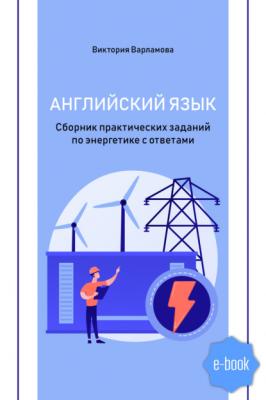Английский язык. Сборник практических заданий по энергетике с ответами. Виктория Варламова
Читать онлайн.| Название | Английский язык. Сборник практических заданий по энергетике с ответами |
|---|---|
| Автор произведения | Виктория Варламова |
| Жанр | Языкознание |
| Серия | |
| Издательство | Языкознание |
| Год выпуска | 0 |
| isbn | 9785996516391 |
1.3. Выберите правильный вариант перевода:
Ответы выделены полужирным курсивом:
| 1. radiant energy | В) энергия излучения |
| 2. elastic potential energy | В) энергия упругости |
| 3. visible light | А) видимый свет |
| 4. the absence of matter | В) (зд.) Отсутствие материи/вещества |
| 5. the molecules of a substance | А) молекулы вещества |
1.4. Найдите существительное в каждой группе слов. Переведите.
Ответы выделен полужирным курсивом.
a) electric, kinetic, to consist of, to accelerate, motion;
b) chemical, normal, electrical, thermal, energy;
c) to classify, to modify, to destroy, velocity, to multiply;
d) longitudinal, mathematical, gravitational, to multiply, equation;
e) to produce, to emit, emission, to change, enormous;
f) to convert, convertible, interconvertible, rotational, pressure;
g) totally, periodically, usually, to conduct, conservation.
1.5. Прочитайте и переведите текст
Energy can be defined as the ability to do work. Physicists classify energy into several types: kinetic, potential, heat, sound, radiant energy (light, for example), and electrical, chemical, and nuclear energy.
Kinetic energy is possessed by a moving object by virtue of its motion. It equals the work done to accelerate the object to a particular velocity; it also equals the work done to bring a moving object to rest..
An object has potential energy by virtue of its position. Two common types are gravitational and elastic potential energy.
An object possesses (обладает) heat, or thermal, energy by virtue of its temperature. It is, in fact, merely a form of kinetic energy, because the temperature of a substance depends on the motion of its component atoms or molecules; the higher its temperature, the faster the molecules move.
Radiant energy consists of electromagnetic radiation and includes radio waves, visible light, ultraviolet and infrared radiation, and X rays. The only form of energy that can exist in the absence of matter, it consists of a wave motion in electric and magnetic fields.
Sound energy consists of moving waves of pressure in a medium such as air, water, or metal. They consist of vibrations in the molecules of the medium.
Matter that has gained or lost some electric charge has electrical energy. The movement of charges constitutes an electric current, which flows between two objects at different potentials when they are joined by a conductor.
Chemical energy is possessed by substances that undergo a chemical reaction, such as combustion. It is stored in the chemical bonds between the atoms that make up the molecules of a substance.
Nuclear energy is produced when the nuclei of atoms change, either by splitting apart or joining together. The splitting process is known as nuclear fission, the joining together as nuclear fusion. Such changes can be accompanied by the release of enormous amounts of energy in the form of heat, light, and radioactivity (the emission of atomic particles or gamma radiation, or both).
The principle of conservation of energy
The total amount of energy, possessed by an object, remains the same. This phenomenon is the principle of conservation of energy, which states, that energy can neither be created nor destroyed, but only converted into other forms.
If mass and energy are considered together, the total amount of mass and energy remains the same. The principle of mass conservation has been modified into what is called the principle of conservation of mass — energy. The Theory of Relativity shows that mass and energy can be considered to be totally interconvertible, and the amount of energy produced, when matter is destroyed, is given by the well — known equation E = mc2 (E is the energy released, m is the mass destroyed, and c is the velocity of light).
1.6. Составьте предложения по образцу:
Ответы выделены полужирным курсивом.
Pattern 1. Physicists classify energy into several types: kinetic, potential, heat, sound, radiant, electrical, chemical and nuclear energy.
Физики классифицируют энергию на несколько типов: кинетическую, потенциальную, тепловую, звуковую, энергию излучения, электрическую, химическую и ядерную.
1. Physicists classify physical science into several fields: mechanics, sound, heat, electricity, etc.
2. Physicists classify particles into several types: electrons, protons, neutrons, etc.
3. Physicists classify states of matter into several types: solid, liquid, gas, plasma
4. Physicists classify solids into two types: “true” and amorphous.
5. Physicists classify substances in solution into two types: crystalloids and colloids
Pattern 2. The two principal forms of kinetic energy are known as translation and rotational. Две основные формы кинетической энергии известны как поступательная и вращательная
1. The two branches of physics are known as experimental and theoretical physics.
2. The four states of matter are known as solid, gas, liquid and plasma.
3. The three principal types of forces are known as gravitational, friction and viscous forces.
4. The two principal types of substances in solution are known as colloids and crystalloids.
5. The two types of solids are known as “true” and amorphous
